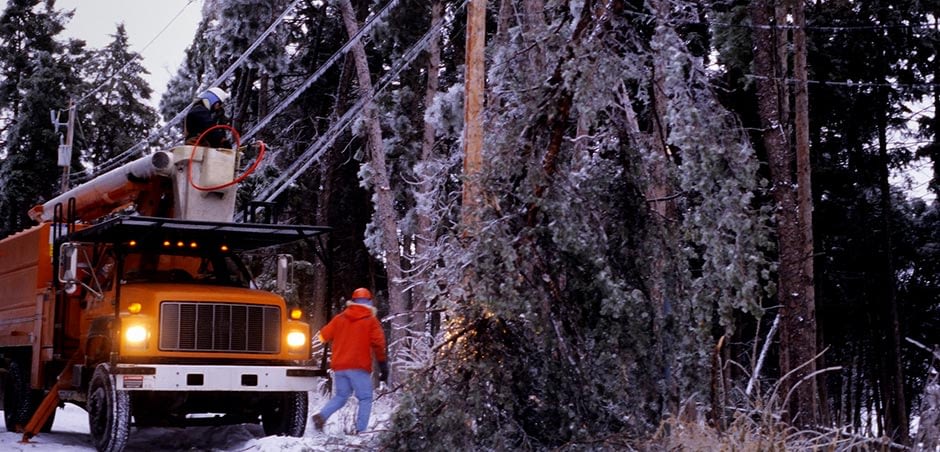In many places, dealing with winter weather like snow, sleet and ice is a normal part of life. But there’s a less common type of winter storm that can cause significant damage no matter where you live: ice storms.
Unlike a winter storm or blizzard that brings high winds and heavy snowfall, an ice storm results in the accumulation of ice on outdoor surfaces – from roads and walkways to trees and power lines.
To help you prepare the next time an ice storm is in the forecast, here’s everything you need to know about this winter weather event.
What is an ice storm?
According to The National Severe Storms Laboratory (NSSL), an ice storm is caused by freezing rain which results in the accumulation of at least .25” of ice on exposed surfaces.
Freezing rain occurs when there is a layer of warm air between two layers of cold, freezing air. As snowflakes fall from the sky and travel through that warm layer of air, they melt into rain drops. But upon reaching the ground, the cold air below causes the rain to refreeze as soon as it contacts a surface.
This leads to a glaze of ice covering anything the freezing rain touches. And when it rains like this for hours on end, enough ice accumulates to qualify as an ice storm.
How does an ice storm differ from a hail storm?
Hail is also a form of frozen rain. But the main difference between a hail storm and an ice storm is that hail freezes before it hits the ground.
While freezing rain is snow that melts to rain and refreezes, hail starts out as raindrops. These raindrops are drawn into the cold upper atmosphere by thunderstorm updrafts, where they freeze, forming round hailstones. When the hailstones get heavy enough, or the updraft weakens, the hail falls to the ground as frozen balls of ice.
Where do ice storms occur?
Ice storms and freezing rain are most common in the Midwest and Northeast regions of the United States. But because they require warm pockets of air, they can occur much further south than other forms of winter weather – including areas of Texas, Louisiana, Missouri, Alabama and the Carolinas.
The effects of ice storms in traditionally warmer climates can be especially devastating – since residents, road crews and utility companies are less prepared for winter weather events.
What kind of damage can an ice storm cause?
Ice storms can cause damage in a number of ways.
- Dangerous driving conditions: Perhaps the most obvious impact is that it transforms surfaces like roads and sidewalks into an ice skating rink. Much like black ice, it can be extremely hazardous to walk or drive on slippery icy roads. For example, in February 2021, freezing rain in Fort Worth, Texas led to a 133-car pileup on Interstate 35, taking the lives of six people during their morning commute. Learn more about how to drive on black ice.
- Downed trees and power lines: According to The Weather Channel, ice accumulation can increase the weight of tree branches up to 30 times. And it can add 500 pounds of extra weight to power lines. Strong winds can compound the effects of this extra weight, toppling trees and snapping utility poles.
- Power outages: In January 1998, areas of northern New England, upstate New York and southeastern Canada were without power for weeks after an ice storm left ice accumulations of up to three inches in some places. Millions of people lost power, and the property damages totaled more than $3 billion.
How long can an ice storm last?
The freezing rain that causes an ice storm typically lasts for a period of several hours. But the ice and damage it leaves in its wake can take days, or even weeks, to clean up.
Fallen trees can block roadways. Downed power lines can leave homes without power. And because ice can’t be plowed off the road like snow, drivers must wait until all the ice is melted before roadways are safe again. In warmer climates where road departments don’t have plows, salt and other ice-melting agents, the melting time is often up to mother nature.
Related: Should I Pump My Brakes When Driving on Ice?
How can you prepare for an ice storm?
Here are a few ways you can protect your home and family during an ice storm.
- Stay off the roads. Driving on icy roads can be extremely dangerous. When an ice storm is in the forecast, don’t plan on driving unless it’s absolutely necessary. If you absolutely must venture out, snow tires can make a world of difference. Learn how snow tires work and how to shop for them.
- Prepare for a power outage. During an ice storm, it’s highly likely you may find yourself without power. Read up on how to survive a power outage and make sure you have a well-stocked home emergency kit. You may even want to consider purchasing a backup power generator. Remember to never operate a generator indoors.
- Install a carbon monoxide detector. If you plan to use a gas-powered generator during a power outage, make sure you keep it well ventilated and have carbon monoxide detectors inside your home.
- Remove ice dams. An ice dam a ridge of ice that occurs on the edge of the roof of your house that prevents melting snow and ice from draining off your home’s roof. It can also lead to interior water damage. To remove it, apply an ice melt product like calcium chloride, which will melt the ice and allow water to flow off the roof and gutters. Learn more about ice dams and how to remove them.
Can an ice storm damage my home?
Ice storms can also cause damage to your home. Some potential issues can include:
- Water leaks: Ice dams and other ice-related roofing problems can cause water to enter your home.
- Frozen pipes: Cold temperatures can lead to bursting frozen pipes.
- Roof collapse: The extra weight from all that ice could be more than your home’s roof can bear.
Talk to an insurance professional like your local ERIE agent to understand the ins-and-outs of your homeowners insurance. Your agent can explain what kind of damage homeowners insurance can (and can’t) cover, and how to stay protected from the unexpected things in life.
Related Reading: Ice Storms, Frozen Pipes, and Black Ice
Stay safe out there! Check out these related stories from the Eriesense blog:
- How to Prevent Frozen Pipes (And What to Do If They Freeze Anyway)
- What Happens If My Neighbor’s Tree Falls in My Yard?
- 7 Tips for Staying Safe During Extreme Cold Weather
- Safe Home Heating: Tips for Fireplaces, Space Heaters and More
- How NOT To Drive in Winter Weather
Article originally posted on www.erieinsurance.com(opens in new tab)

A better insurance experience starts with ERIE.
Haven’t heard of us? Erie Insurance started with humble beginnings in 1925 with a mission to emphasize customer service above all else. Though we’ve grown to reach the Fortune 500 list, we still haven’t lost the human touch.
Contact Hostetler & Young Insurance Agency today to experience the ERIE difference for yourself.



